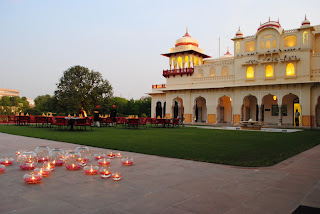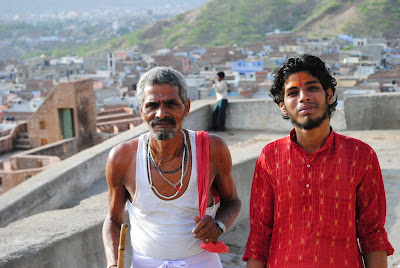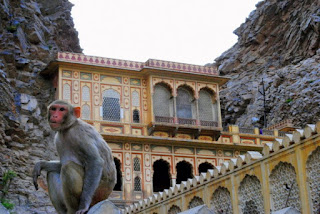Tradition and history are absolutely engrained here, despite the sounds of modern life continually bombarding you, from the nasal horns of tiny cars to continual whir of air conditioning fans. Somewhere a shopkeeper throws open the gates to his matchbox-sized niche of commerce and a cell phone plays an oddly familiar tune. Wait? Could that be? Why, yes. Yes, it is. It’s Lady Gaga.
Perhaps the most contradictory, not to mention enchanting, is the fact that this all occurs at the steps of some of the most stunning temples and architectural dreamworks to adorn the planet. It takes me a second to process the fact that text messages are being sent beneath the gaze of Ganesha, this version lovingly and skillfully carved in cloudy marble nearly 500 years ago.
Interacting with these structures and each of their sculptural details has quickly become one of my favorite ways to musingly pass an afternoon. Nothing like a few hours spent with cornices, mosaics, turrets, and religious idols, right?
Naturally, I wanted to go see the Rambagh Palace in Jaipur. Resting on a throne of 47  manicured acres, it regally resists the urban bedlam outside its gates. What’s distinct about this particular palace, however, is the fact that it’s no longer maintained by the Indian government or even some benevolent NGO. It was converted into a 5-star resort, owned and maintained by the Taj Hotels group, where a single evening can deduct up to $13,000 from your bank account. The median income in Rajahstan, in which Jaipur is the capital, is $700. Per year.
manicured acres, it regally resists the urban bedlam outside its gates. What’s distinct about this particular palace, however, is the fact that it’s no longer maintained by the Indian government or even some benevolent NGO. It was converted into a 5-star resort, owned and maintained by the Taj Hotels group, where a single evening can deduct up to $13,000 from your bank account. The median income in Rajahstan, in which Jaipur is the capital, is $700. Per year.
 manicured acres, it regally resists the urban bedlam outside its gates. What’s distinct about this particular palace, however, is the fact that it’s no longer maintained by the Indian government or even some benevolent NGO. It was converted into a 5-star resort, owned and maintained by the Taj Hotels group, where a single evening can deduct up to $13,000 from your bank account. The median income in Rajahstan, in which Jaipur is the capital, is $700. Per year.
manicured acres, it regally resists the urban bedlam outside its gates. What’s distinct about this particular palace, however, is the fact that it’s no longer maintained by the Indian government or even some benevolent NGO. It was converted into a 5-star resort, owned and maintained by the Taj Hotels group, where a single evening can deduct up to $13,000 from your bank account. The median income in Rajahstan, in which Jaipur is the capital, is $700. Per year.My curiosity was piqued. Also – let’s be honest – I wanted a stiff cocktail, an indulgence not found in my budget accommodations.
Surprisingly (or not?) Rambagh Palace was the most beautifully restored palace I have seen thus far. Each marble carving was exquisite, every plant tended to, each wall perfectly smooth and painted, every mosaic intact and gleaming, each alabaster chandelier wired and glowing. Peacocks roamed the grounds. The scent of jasmine welcomed you as you were met by a genuflection and a Namaste. The lighting was perfect. I mean, it’s one o f those places where everybody looks good. Compact fluorescents be damned, Rambagh made sure everyone was cast in a flattering light.
f those places where everybody looks good. Compact fluorescents be damned, Rambagh made sure everyone was cast in a flattering light.
 f those places where everybody looks good. Compact fluorescents be damned, Rambagh made sure everyone was cast in a flattering light.
f those places where everybody looks good. Compact fluorescents be damned, Rambagh made sure everyone was cast in a flattering light.As I sat there attempting to blend in, a teacher amongst a calm sea of executives, I couldn’t help but think about the original intention of the palace. Yes, of course, it was a home for the maharaja; but it was also an ostentatious display of his wealth. The wealthy and the royal from near and far would come to be entertained, wined, and dined. Perhaps his power was best shown by the caliber of the entertainment, the gastronomic spread, the overall splendor of the evening.
Ironically, not much has changed. Live music still soothes. Dance performances still awe. The wealthy are still surrounding the courtyard. And the regal? Well, Anderson Cooper and his boyfriend came here not long ago, and as a Vanderbilt descendent, he’s about as close as we come to American royalty. There has been, however, a slight power change. No longer is it the host who must flaunt his riches, but rather the guest. The question becomes, then, how much is he or she willing to spend? How much is this temporary utopia worth? What can Rambagh Palace charge for the re-creation of an era and a giant pair of rosy glasses? For me, apparently, that cost was a twelve dollar drink. For those around me, that cost was much more.
As I left that night, slipping back into Rajahstani reality, I found myself haggling with a rickshaw driver over ten rupees, less than a quarter. I felt dirty. Was I that willing to give my money to the Taj Hotels but not to the man who safely returned me to my much more meager lodgings?  What did this say about me? About the influence of clever marketing? Why are we willing to pay so much put ourselves in an environment that someone has decided is pleasurable? Desirable? Worthy of hoards of cash?
What did this say about me? About the influence of clever marketing? Why are we willing to pay so much put ourselves in an environment that someone has decided is pleasurable? Desirable? Worthy of hoards of cash?
 What did this say about me? About the influence of clever marketing? Why are we willing to pay so much put ourselves in an environment that someone has decided is pleasurable? Desirable? Worthy of hoards of cash?
What did this say about me? About the influence of clever marketing? Why are we willing to pay so much put ourselves in an environment that someone has decided is pleasurable? Desirable? Worthy of hoards of cash? The next day, I took in the sunset at Galta (aka the Monkey Palace) where a series of amber structures honored the Hindu deity Hanuman. Tucked away between soaring mountains, it’s a fascinating place – simian families parallel the human ones, men and women bathe and swim in a pool fed by a single stream of water coming from the mouth of a carved sacred cow. It’s indescribably ambient and tranquil, two words I would have also used to describe the previous night at Rambagh Palace. Authenticity, however, is lost at Rambagh. The cost of Galta? 100 rupees. $2.16.
I find it poignant that I’m writing this as I sit in the Mumbai airport, a layover en route to Bengalaru to visit the lovely Mangala. I’m paying for this atmosphere. It’s sterilized, anglicized under the smooth curves of modern architecture. Slick red chairs rest next to triangular stainless steel planters. The digitized tonal trio introduces a boarding announcement, entirely in English. I wait a moment for the Hindi or Marathi version, almost as an afterthought, but one never comes. I sip my four dollar coffee. 


Very interesting Joe. Good for you for sitting with your twelve dollar drink and experiencing being a part of that. Please continue to post as many photos as possible, it really helps us to be able to see what you are seeing. And by the way, who are these two guys that you posted here?
ReplyDeleteGreat reading!! I love your description of the disparity between castes. I'm glad you are able to experience both. I can't wait to see more photos and more of your writing!!
ReplyDeleteWhat poignant reflections... this is such a treat to expeience with you! Thanks for writing : )
ReplyDeleteI'm loving this. You definitely have writing skills.
ReplyDelete